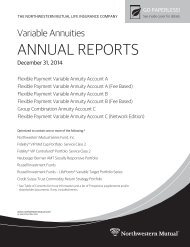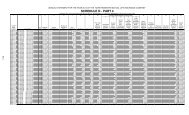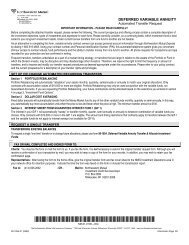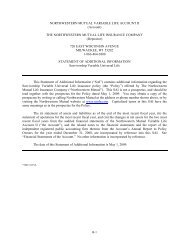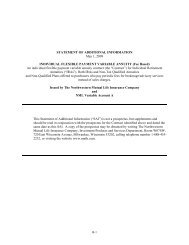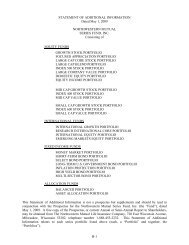subordinate corporate loans, including loans that may be rated below investment grade or equivalentunrated loans. CDOs may charge management fees and administrative expenses.For both CBOs and CLOs, the cashflows from the trust are split into two and more portions,called tranches, varying in risk and yield. The riskiest portion is the “equity” tranche which bears thebulk of defaults from the bonds or loans in the trust and serves to protect the other, more seniortranches from default in all but the most severe circumstances. Since it is partially protected fromdefaults, a senior tranche from a CBO trust or CLO trust typically have higher ratings and loweryields than their underlying securities, and can be rated investment grade. Despite the protectionfrom the equity tranche, CBO or CLO tranches can experience substantial losses due to actualdefaults, increased sensitivity to defaults due to collateral default and disappearance of protectingtranches, market anticipation of defaults, as well as aversion to CBO or CLO securities as a class.The risks of an investment in a CDO depend largely on a type of the collateral securities and theclass of the CDO in which a Portfolio invests. Normally, CBOs, CLOs and other CDOs are privatelyoffered and sold, and thus, are not registered under the securities laws. As a result, investments inCDOs may be characterized by the Portfolios as illiquid securities; however, an active dealer marketmay exist for CDOs allowing a CDO to qualify for Rule 144A transactions. In addition to the normalrisks associated with fixed income securities discussed elsewhere in this SAI and the Portfolios’Prospectuses (e.g., interest rate risk and default risk), CDOs carry additional risks including, but notlimited to: (i) the possibility that distributions from collateral securities will not be adequate to makeinterest or other payments; (ii) the quality of the collateral may decline in value or default; (iii) thePortfolios may invest in COs that are subordinate to other classes; and (iv) the complex structure ofthe security may not be fully understood at the time of investment and may produce disputes with theissuer or unexpected investment results.Other Asset-Backed Securities. Similar to mortgage-backed securities, other types of assetbackedsecurities may be issued by agencies or instrumentalities of the U.S. government (includingthose whose securities are neither guaranteed nor insured by the U.S. government), foreigngovernments (or their agencies or instrumentalities), or non-governmental issuers. These securitiesinclude securities backed by pools of automobile loans, educational loans, home equity loans, andcredit-card receivables. The underlying pools of assets are securitized through the use of trusts andspecial purpose entities. These securities may be subject to risks associated with changes in interestrates and prepayment of underlying obligations similar to the risks of investment in mortgage-backedsecurities described above.Payment of interest on asset-backed securities and repayment of principal largely depends on thecash flows generated by the underlying assets backing the securities and, in certain cases, may besupported by letters of credit, surety bonds, or other credit enhancements. The amount of market riskassociated with asset-backed securities depends on many factors, including the deal structure (i.e.;determinations as to the amount of underlying assets or other support needed to produce the cashflows necessary to service interest and make principal payments), the quality of the underlying assets,the level of credit support, if any, provided for the securities, and the credit quality of the creditsupportprovider, if any. Asset-backed securities involve risk of loss of principal if obligors of theunderlying obligations default and the amounts defaulted exceed the securities’ credit support.The value of an asset-backed security may be affected by the factors described above and otherfactors, such as the availability of information concerning the pool and its structure, thecreditworthiness of the servicing agent for the pool, the originator of the underlying assets, or theentities providing the credit enhancement. The value of asset-backed securities also can depend onthe ability of their servicers to service the underlying collateral and is, therefore, subject to risksassociated with servicers’ performance. In some circumstances, a servicer’s or originator’smishandling of documentation related to the underlying collateral (e.g.; failure to properly documenta security interest in the underlying collateral) may affect the rights of the security holders in and tothe underlying collateral. In addition, the insolvency of entities that generate receivables or thatB-28
utilize the underlying assets may result in a decline in the value of the underlying assets as well ascosts and delays.Certain types of asset-backed securities present additional risks that are not presented bymortgage-backed securities. In particular, certain types of asset-backed securities may not have thebenefit of a security interest in the related assets. For example, many securities backed by credit-cardreceivables are unsecured. In addition, a Portfolio may invest in securities backed by unsecuredcommercial or industrial loans or unsecured corporate or sovereign debt (see “Collateralized DebtObligations” (“CDOs”) above). Even when security interests are present, the ability of an issuer ofcertain types of asset-backed securities to enforce those interests may be more limited than that of anissuer of mortgage-backed securities. For instance, automobile receivables generally are secured, butby automobiles rather than by real property. Most issuers of automobile receivables permit loanservicers to retain possession of the underlying assets. In addition, because of the large number ofunderlying vehicles involved in a typical issue of asset-backed securities and technical requirementsunder state law, the trustee for the holders of the automobile receivables may not have a propersecurity interest in all of the automobiles. Therefore, recoveries on repossessed automobiles may notbe available to support payments on these securities.In addition, certain types of asset-backed securities may experience losses on the underlyingassets as a result of certain rights provided to consumer debtors under federal and state law. In thecase of certain consumer debt, such as credit-card debt, debtors are entitled to the protection of anumber of state and federal consumer credit laws, many of which give such debtors the right to set offcertain amounts owned on their credit-cards (or other debt), thereby reducing their balances due. Forinstance, a debtor may be able to offset certain damages for which a court has determined that thecreditor is liable to the debtor against amounts owned to the creditor by the debtor on his or hercredit-card.Future DevelopmentsThe Portfolios may take advantage of opportunities in the area of options and futures contractsand options on futures contracts and any other derivative product which is not presently contemplatedfor use by the Portfolios or which are not currently available, but which may be developed, to theextent such opportunities are both consistent with the Portfolios’ respective investment objectives andlegally permissible for the Portfolios. Before making such investments, the Fund would supplementthe disclosure in its Prospectus or SAI, if it determined it to be appropriate.Adjustable Rate Securities (Including Variable Rate Securities)Generally, the maturity of a security is the period remaining until the date (noted on theinstrument) on which the principal amount of the instrument must be paid; in the case of a securityscheduled to be redeemed, this is the date on which the redemption payment must be made. In somecases, securities are issued that either provide for payment upon “demand” or that provide for a periodicadjustment of the interest rate by a predetermined formula or based on an index such that fluctuation inthe principal value of the security is minimized. As a technical matter, such securities may have long-termmaturities, but typically are treated as a short-term investment if certain conditions are satisfied. Thesesecurities, which may take a variety of forms including variable rate, floating rate and put optionsecurities, have less potential for capital appreciation (or depreciation) than fixed rate securities. Each ofthe Portfolios may invest in variable rate securities. For the Money Market Portfolio, the Portfoliodetermines the maturity of variable rate securities in accordance with Securities and ExchangeCommission Rule 2a-7 under the 1940 Act that allow the Portfolio to consider certain of such instrumentsas having maturities less than the maturity date on the instrument.The Money Market Portfolio may invest in certain short-term variable rate securities that give theinvestor the right to extend the maturity date. The Money Market Portfolio may elect to extend thematurity of such securities to the extent the adjusted maturity does not exceed 397 days from the date ofB-29
- Page 4: APPENDIX F - Proxy Voting Policies
- Page 9 and 10: stocks that make up that index. Str
- Page 11 and 12: Interest rate swaps do not involve
- Page 13 and 14: the Adviser or Sub-Adviser will not
- Page 17 and 18: Forward Contracts. The Portfolios m
- Page 19 and 20: principal amount as the call writte
- Page 21 and 22: Options on Foreign Currencies. The
- Page 23 and 24: securities. The issuers of the unde
- Page 25 and 26: the former pools. However, timely p
- Page 27: CMO residuals are generally purchas
- Page 32 and 33: include range floaters which are a
- Page 34 and 35: par unless the price of the underly
- Page 36 and 37: to changes in interest rates genera
- Page 38 and 39: corresponding floaters. The underly
- Page 40 and 41: A Portfolio will not enter into suc
- Page 42 and 43: egulations. The presence of an issu
- Page 44 and 45: Portfolio TurnoverPortfolio turnove
- Page 46 and 47: The ability of the Portfolio to ach
- Page 48 and 49: Advisors, LLC, in accordance with t
- Page 50 and 51: OWNERSHIP OF SHARES OF THE FUNDAll
- Page 52 and 53: on the next $50 million, 0.50% on t
- Page 54 and 55: Independent Registered Public Accou
- Page 56 and 57: Name of Portfolio 2008 2007 2006Int
- Page 58 and 59: Broker High Yield Bond BalancedAsse
- Page 60 and 61: and cost of trade execution of Port
- Page 62 and 63: Effective April 30, 2008, the Fund
- Page 64 and 65: TAXES AND DIVIDENDSEach Portfolio i
- Page 66 and 67: APPENDIX A - Credit RatingsDescript
- Page 68 and 69: F2Good credit quality. A satisfacto
- Page 70 and 71: . Moody’s Commercial Paper (short
- Page 72 and 73: Plus (+) or minus (-)The ratings fr
- Page 74 and 75: APPENDIX B - Directors and Officers
- Page 76 and 77: Name, Address, andYear of BirthDavi
- Page 78 and 79:
APPENDIX C - Ownership of Shares of
- Page 80 and 81:
SMALL CAP VALUE PORTFOLIOGeneral Ac
- Page 82 and 83:
APPENDIX D - Portfolio ManagersOthe
- Page 84 and 85:
PortfolioManager(s)FundRegisteredIn
- Page 86 and 87:
Compensation of Portfolio ManagersM
- Page 88 and 89:
management firms. Performance is pr
- Page 90 and 91:
Portfolio managers are eligible for
- Page 92 and 93:
PortfolioPortfolio Manager(s)Dollar
- Page 94 and 95:
On August 25, 2005, the Court enter
- Page 96 and 97:
MSA’s Equity Trading Department s
- Page 98 and 99:
ERISA ClientsIn the case of client
- Page 100 and 101:
Shareholder Ability to Call Special
- Page 102 and 103:
• Exercise price• Participation
- Page 104 and 105:
Amend Quorum RequirementsVote propo
- Page 106 and 107:
Vote proposals to increase blank ch
- Page 108 and 109:
employees of Investment Manager and
- Page 110 and 111:
will not support the position of a
- Page 112 and 113:
company specifies the voting, divid
- Page 114 and 115:
egarding whether Investment Manager
- Page 116 and 117:
3. The issuer is an entity particip
- Page 118 and 119:
manager(s) are responsible for maki
- Page 120 and 121:
Global Corporate Governance: Invest
- Page 122 and 123:
13. The Proxy Group will review the
- Page 124 and 125:
determined by those investment comm
- Page 126 and 127:
T. Rowe Price has adopted these Pro
- Page 128 and 129:
shareholders and the effect on shar
- Page 130 and 131:
portfolio company could have influe
- Page 132 and 133:
The Proxy Voting Service will refer
- Page 134 and 135:
that substantially differs from dom
- Page 136 and 137:
15. Janus will generally vote in fa
- Page 138 and 139:
46. For shareholder proposals outsi
- Page 140 and 141:
2. Staggered BoardIf a company has
- Page 142 and 143:
proposed for a legitimate business
- Page 144 and 145:
APPENDIX G - Portfolio Holdings Dis
- Page 146:
ICP Securities LLCIntermonte Securi



